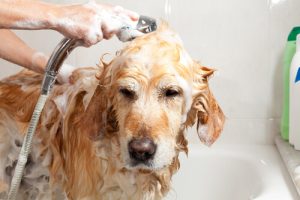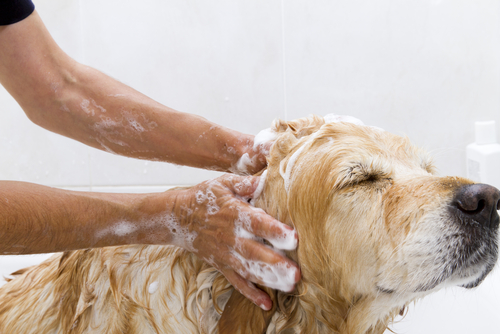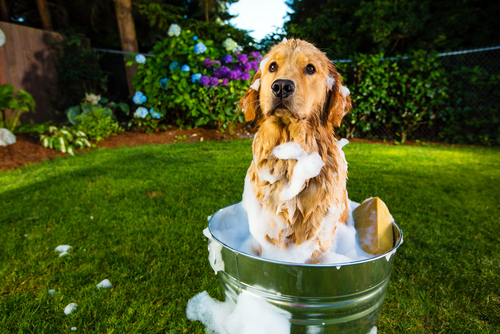9 Myths about Bathing Your Dog

How often, which products to use, and even debating about whether we should bathe them at all are some of the questions that surround the topic of bathing your dog. We’ll fill you in on some of the myths that are out there about bathing your dog and grooming your furry friend.
1-Since wild animals don’t bathe, we don’t need to bathe our pets

In nature, animals usually deal with the issue of cleanliness with a good mud bath, which actually helps get rid of parasites on their skin and fur. But in cities, with excessive pollution and toxins, bathing your dog is not only a matter of aesthetics, but also of health.
2-Dogs should not be bathed often
The best idea is to bathe your dog regularly. How much time you wait in between baths depends on a variety of factors, including the characteristics of their fur. Ask the veterinarian what is best for your pet. In addition, dogs that suffer from skin diseases or allergies require more frequent bathing and with specific products.
There are many myths circulating in relation to how to bathe dogs. We tell you which ones are false so that you avoid mistakes and take better care of the skin and fur of your favorite four-legged friend.
3-Bathing your dog a can damages the pH of their skin
This only happens if you do not use a suitable shampoo for dogs. So don’t just grab any shampoo from the bathroom to wash your dog. Humans and dogs have different pH needs. Don’t even think about using a shampoo for human hair to bathe your dog. We recommend, once again, that you ask your veterinarian with shampoo they recommend for your pet.
4-A bath can make them lose their skins’ natural oils
Unless you’re excessive in the grooming of your four-legged friend, this shouldn’t be a problem, especially if you’re use a good quality shampoo that is specifically for dogs. A bath will remove impurities and other substances that you need to get rid of so that your dog has an enviable coat of fur and healthy skin.
5-The water can cause ear infection
Unless something goes wrong or you’re careless, you should not have to put water in your pet’s ears during a bath. No water, no ear infection. Pay attention to your dog’s ears during bath time and carefully remove the remains of shampoo from your dog’s ears. And, if water does get in your pet’s ears, consult a veterinarian.
6-It is necessary to use a hair dryer to dry your dog after a bath
Dogs generally do not like the noise of hair dryers. The heat can upset your dog as well. Unless it’s too cold for your dog to air dry, towel your dog off after a bath, and let him dry naturally in a warm, sheltered environment.
7-One application of an anti-flea shampoo is enough to eliminate these annoying parasites
This also is a big factor in the regularity with which you should bathe your dog. Don’t think that with a single application you have gotten rid of those annoying bugs that plague your pet. In order to completely get rid of them, you need to use several different treatments. For example:
- Powders
- Spot treatments
- Sprays
Also, if your dog is free of parasites, it is not necessary to use a flea-shampoo.

8-The hose is a great way to bathe your dog
Except on a very hot summer day when the sun is out in full force, you shouldn’t ever bathe your dog with cold water from the garden hose. This more often than not can make your dog sick. Unless it is sweltering outside, the best idea is to bathe your dog with warm water inside, where he is safe from the cold and drafts.
9-It’s better to take your dog to a groomers
This statement is not entirely true. Before leaving your dog in the hands of a groomer, make sure to check what products they use and that they treat the animals well. Also, remember that to dry your dog, they will subject to him extensive sessions with a hair dryer. And that’s something that, with few exceptions, most dogs hate.
How often, which products to use, and even debating about whether we should bathe them at all are some of the questions that surround the topic of bathing your dog. We’ll fill you in on some of the myths that are out there about bathing your dog and grooming your furry friend.
1-Since wild animals don’t bathe, we don’t need to bathe our pets

In nature, animals usually deal with the issue of cleanliness with a good mud bath, which actually helps get rid of parasites on their skin and fur. But in cities, with excessive pollution and toxins, bathing your dog is not only a matter of aesthetics, but also of health.
2-Dogs should not be bathed often
The best idea is to bathe your dog regularly. How much time you wait in between baths depends on a variety of factors, including the characteristics of their fur. Ask the veterinarian what is best for your pet. In addition, dogs that suffer from skin diseases or allergies require more frequent bathing and with specific products.
There are many myths circulating in relation to how to bathe dogs. We tell you which ones are false so that you avoid mistakes and take better care of the skin and fur of your favorite four-legged friend.
3-Bathing your dog a can damages the pH of their skin
This only happens if you do not use a suitable shampoo for dogs. So don’t just grab any shampoo from the bathroom to wash your dog. Humans and dogs have different pH needs. Don’t even think about using a shampoo for human hair to bathe your dog. We recommend, once again, that you ask your veterinarian with shampoo they recommend for your pet.
4-A bath can make them lose their skins’ natural oils
Unless you’re excessive in the grooming of your four-legged friend, this shouldn’t be a problem, especially if you’re use a good quality shampoo that is specifically for dogs. A bath will remove impurities and other substances that you need to get rid of so that your dog has an enviable coat of fur and healthy skin.
5-The water can cause ear infection
Unless something goes wrong or you’re careless, you should not have to put water in your pet’s ears during a bath. No water, no ear infection. Pay attention to your dog’s ears during bath time and carefully remove the remains of shampoo from your dog’s ears. And, if water does get in your pet’s ears, consult a veterinarian.
6-It is necessary to use a hair dryer to dry your dog after a bath
Dogs generally do not like the noise of hair dryers. The heat can upset your dog as well. Unless it’s too cold for your dog to air dry, towel your dog off after a bath, and let him dry naturally in a warm, sheltered environment.
7-One application of an anti-flea shampoo is enough to eliminate these annoying parasites
This also is a big factor in the regularity with which you should bathe your dog. Don’t think that with a single application you have gotten rid of those annoying bugs that plague your pet. In order to completely get rid of them, you need to use several different treatments. For example:
- Powders
- Spot treatments
- Sprays
Also, if your dog is free of parasites, it is not necessary to use a flea-shampoo.

8-The hose is a great way to bathe your dog
Except on a very hot summer day when the sun is out in full force, you shouldn’t ever bathe your dog with cold water from the garden hose. This more often than not can make your dog sick. Unless it is sweltering outside, the best idea is to bathe your dog with warm water inside, where he is safe from the cold and drafts.
9-It’s better to take your dog to a groomers
This statement is not entirely true. Before leaving your dog in the hands of a groomer, make sure to check what products they use and that they treat the animals well. Also, remember that to dry your dog, they will subject to him extensive sessions with a hair dryer. And that’s something that, with few exceptions, most dogs hate.
This text is provided for informational purposes only and does not replace consultation with a professional. If in doubt, consult your specialist.








